window Abarth 500 2015 Owner handbook (in English)
[x] Cancel search | Manufacturer: ABARTH, Model Year: 2015, Model line: 500, Model: Abarth 500 2015Pages: 215, PDF Size: 19.08 MB
Page 37 of 215
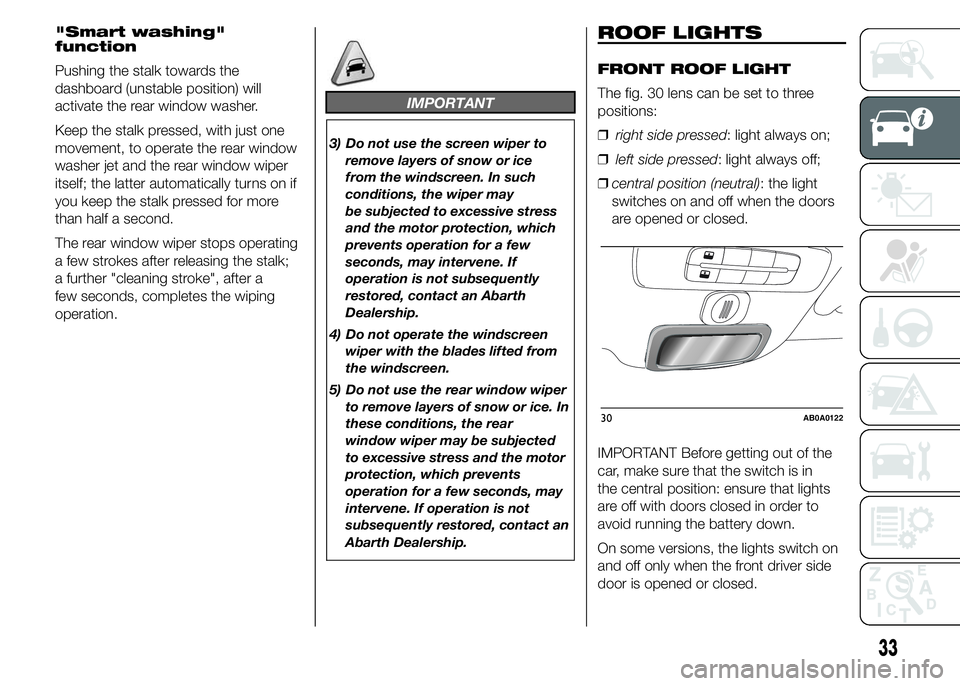
"Smart washing"
function
Pushing the stalk towards the
dashboard (unstable position) will
activate the rear window washer.
Keep the stalk pressed, with just one
movement, to operate the rear window
washer jet and the rear window wiper
itself; the latter automatically turns on if
you keep the stalk pressed for more
than half a second.
The rear window wiper stops operating
a few strokes after releasing the stalk;
a further "cleaning stroke", after a
few seconds, completes the wiping
operation.
IMPORTANT
3) Do not use the screen wiper to
remove layers of snow or ice
from the windscreen. In such
conditions, the wiper may
be subjected to excessive stress
and the motor protection, which
prevents operation for a few
seconds, may intervene. If
operation is not subsequently
restored, contact an Abarth
Dealership.
4) Do not operate the windscreen
wiper with the blades lifted from
the windscreen.
5) Do not use the rear window wiper
to remove layers of snow or ice. In
these conditions, the rear
window wiper may be subjected
to excessive stress and the motor
protection, which prevents
operation for a few seconds, may
intervene. If operation is not
subsequently restored, contact an
Abarth Dealership.
ROOF LIGHTS
FRONT ROOF LIGHT
The fig. 30 lens can be set to three
positions:
❒right side pressed: light always on;
❒left side pressed: light always off;
❒central position (neutral): the light
switches on and off when the doors
are opened or closed.
IMPORTANT Before getting out of the
car, make sure that the switch is in
the central position: ensure that lights
are off with doors closed in order to
avoid running the battery down.
On some versions, the lights switch on
and off only when the front driver side
door is opened or closed.
30AB0A0122
33
Page 48 of 215

ELECTRIC WINDOWS
IN BRIEF
These operate when the ignition key
is turned to MAR-ON and for about
three minutes after the ignition key is
turned to STOP or removed unless
one of the doors is opened.
20)
The electric window control buttons are
located beside the gear lever fig. 47
and activate:
A Opening/closing of the left window.
B Opening/closing of the right
window.
21)
If the button is held down for several
seconds, the window raises or lowers
automatically (only with key in MAR-ON
position).
As regards the passenger's side
window, only the opening occurs
automatically with the same procedure.
WARNING
20) Incorrect use of the electric
windows may be dangerous.
Before and during operation,
always check that nobody is
exposed to the risk of being
injured either directly by the
moving window or through
objects getting caught or hit by it.
21) When leaving the car, always
remove the ignition key to avoid
the risk of injury for people still on
board due to accidental operation
of the electric windows.
47AB0A0225
44
GETTING TO KNOW YOUR CAR
Page 105 of 215
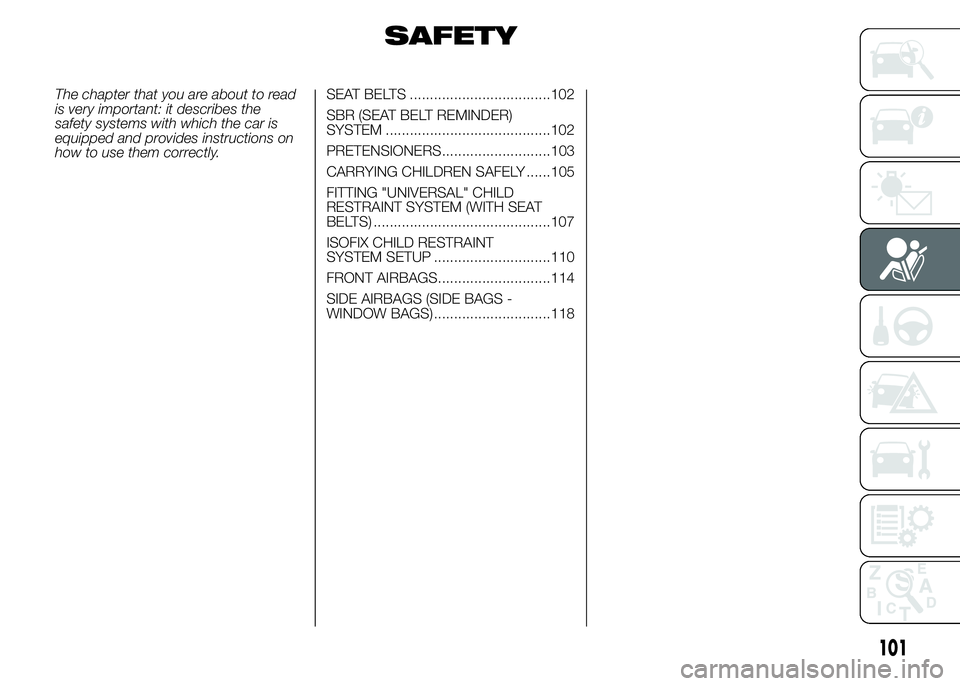
SAFETY
The chapter that you are about to read
is very important: it describes the
safety systems with which the car is
equipped and provides instructions on
how to use them correctly.SEAT BELTS ...................................102
SBR (SEAT BELT REMINDER)
SYSTEM .........................................102
PRETENSIONERS...........................103
CARRYING CHILDREN SAFELY ......105
FITTING "UNIVERSAL" CHILD
RESTRAINT SYSTEM (WITH SEAT
BELTS) ............................................107
ISOFIX CHILD RESTRAINT
SYSTEM SETUP .............................110
FRONT AIRBAGS............................114
SIDE AIRBAGS (SIDE BAGS -
WINDOW BAGS) .............................118
101
Page 122 of 215

SIDE AIRBAGS (SIDE
BAGS - WINDOW
BAGS)
To increase protection of occupants in
the event of side impact, the car is
equipped with side bags for pelvis,
chest and shoulder protection (Side
bags) for the driver and the passenger
and airbags protecting the head.
Non-activation of side bags in other
types of collisions (front collisions, rear
shunts, roll-overs, etc.) does not
indicate a system malfunction.FRONT SIDE AIRBAGS
(SIDE BAGS)
These comprise two types of bags
located in the front seat backrests
fig. 92 which protect the pelvic, chest
and shoulder area of the occupants in
the event of a side impact of
medium-high severity.SIDE AIRBAGS FOR
HEAD PROTECTION
(WINDOW BAGS)
These comprise two "curtain" bags
located behind the side roof cover and
covered by special trim.fig. 93 They
are designed to protect the head of
front and rear passengers in the event
of side impacts, thanks to their wide
inflation surface.
IMPORTANT In the event of a side
impact, the system provides best
protection if the passenger sits on the
seat in a correct position, thus allowing
correct window bag deployment.
92AB0A0074
93AB0A0075
118
SAFETY
Page 123 of 215

IMPORTANT The front airbags and/or
side bags may be deployed if the car is
subject to heavy knocks or accidents
involving the underbody area, such
as for example violent shocks against
steps, pavements or low obstacles, the
car falling in big holes or dips in the
road.
IMPORTANT A small amount of dust
will be released when the airbags
are deployed. The dust is not harmful
and does not indicate the beginning of
a fire. Furthermore, the surface of the
deployed bag and the interior of the car
may be covered by a dusty residue:
this may irritate skin and eyes. Wash
with mild soap and water in the event of
exposure.IMPORTANT Should an accident occur
in which any of the safety devices are
activated, take the vehicle to an Abarth
Dealership to have the activated
devices replaced and to have the whole
system checked.
Every control, repair and replacement
operation concerning the airbags must
only be carried out at an Abarth
Dealership. If the car is scrapped, have
the system deactivated at an Abarth
Dealership.
IMPORTANT Pretensioners, front
airbags and side bags are deployed
according to different logics on the
basis of the type of collision. Failure to
deploy of one of the devices does
not necessarily indicate a system
malfunction.
84) 85) 86) 87) 88) 89) 90) 91) 92) 93) 94) 95)
WARNING
84) Do not rest your head, arms or
elbows on the door, windows or
in the window bag area to prevent
injury during deployment.
85) Never lean your head, arms and
elbows out of the window.
86) If, when turning the key to
MAR-ON, the
warning light
does not turn on or if it stays on
when travelling, there could be
a fault in the restraint systems; in
this event airbags or
pretensioners may not be
deployed in the event of impact
or, in a lower number of cases,
they may deploy accidentally.
Before driving off, contact
an Abarth Dealership to have the
system checked immediately.
87) Do not cover the front seat
backrests with extra covers if they
are equipped with side bags.
119
Page 129 of 215
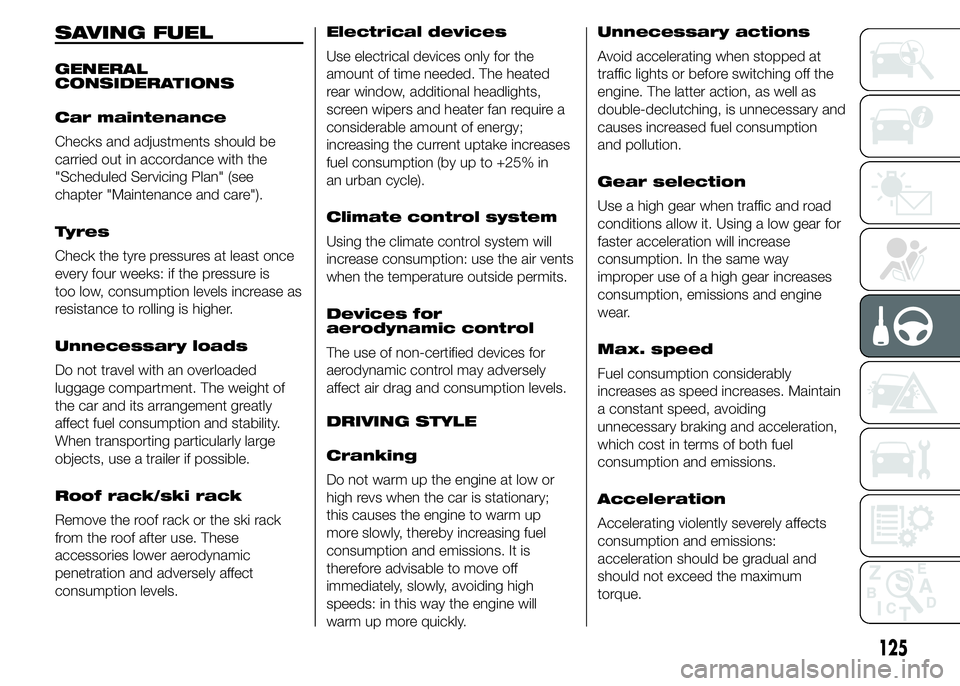
SAVING FUEL
GENERAL
CONSIDERATIONS
Car maintenance
Checks and adjustments should be
carried out in accordance with the
"Scheduled Servicing Plan" (see
chapter "Maintenance and care").
Tyres
Check the tyre pressures at least once
every four weeks: if the pressure is
too low, consumption levels increase as
resistance to rolling is higher.
Unnecessary loads
Do not travel with an overloaded
luggage compartment. The weight of
the car and its arrangement greatly
affect fuel consumption and stability.
When transporting particularly large
objects, use a trailer if possible.
Roof rack/ski rack
Remove the roof rack or the ski rack
from the roof after use. These
accessories lower aerodynamic
penetration and adversely affect
consumption levels.Electrical devices
Use electrical devices only for the
amount of time needed. The heated
rear window, additional headlights,
screen wipers and heater fan require a
considerable amount of energy;
increasing the current uptake increases
fuel consumption (by up to +25% in
an urban cycle).
Climate control system
Using the climate control system will
increase consumption: use the air vents
when the temperature outside permits.
Devices for
aerodynamic control
The use of non-certified devices for
aerodynamic control may adversely
affect air drag and consumption levels.
DRIVING STYLE
Cranking
Do not warm up the engine at low or
high revs when the car is stationary;
this causes the engine to warm up
more slowly, thereby increasing fuel
consumption and emissions. It is
therefore advisable to move off
immediately, slowly, avoiding high
speeds: in this way the engine will
warm up more quickly.Unnecessary actions
Avoid accelerating when stopped at
traffic lights or before switching off the
engine. The latter action, as well as
double-declutching, is unnecessary and
causes increased fuel consumption
and pollution.
Gear selection
Use a high gear when traffic and road
conditions allow it. Using a low gear for
faster acceleration will increase
consumption. In the same way
improper use of a high gear increases
consumption, emissions and engine
wear.
Max. speed
Fuel consumption considerably
increases as speed increases. Maintain
a constant speed, avoiding
unnecessary braking and acceleration,
which cost in terms of both fuel
consumption and emissions.
Acceleration
Accelerating violently severely affects
consumption and emissions:
acceleration should be gradual and
should not exceed the maximum
torque.
125
Page 132 of 215
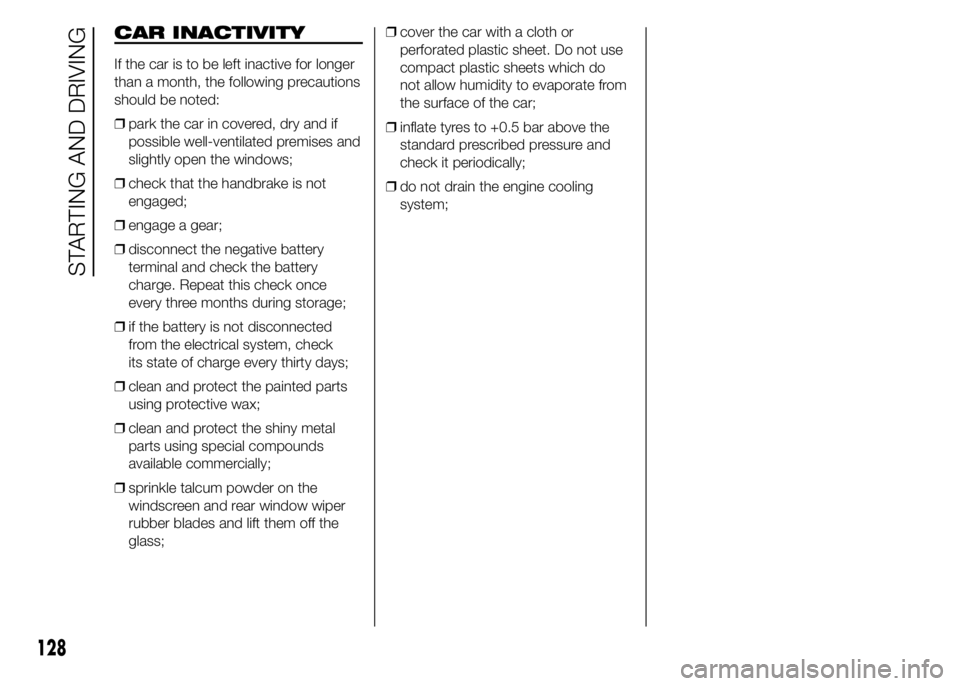
CAR INACTIVITY
If the car is to be left inactive for longer
than a month, the following precautions
should be noted:
❒park the car in covered, dry and if
possible well-ventilated premises and
slightly open the windows;
❒check that the handbrake is not
engaged;
❒engage a gear;
❒disconnect the negative battery
terminal and check the battery
charge. Repeat this check once
every three months during storage;
❒if the battery is not disconnected
from the electrical system, check
its state of charge every thirty days;
❒clean and protect the painted parts
using protective wax;
❒clean and protect the shiny metal
parts using special compounds
available commercially;
❒sprinkle talcum powder on the
windscreen and rear window wiper
rubber blades and lift them off the
glass;❒cover the car with a cloth or
perforated plastic sheet. Do not use
compact plastic sheets which do
not allow humidity to evaporate from
the surface of the car;
❒inflate tyres to +0.5 bar above the
standard prescribed pressure and
check it periodically;
❒do not drain the engine cooling
system;
128
STARTING AND DRIVING
Page 150 of 215
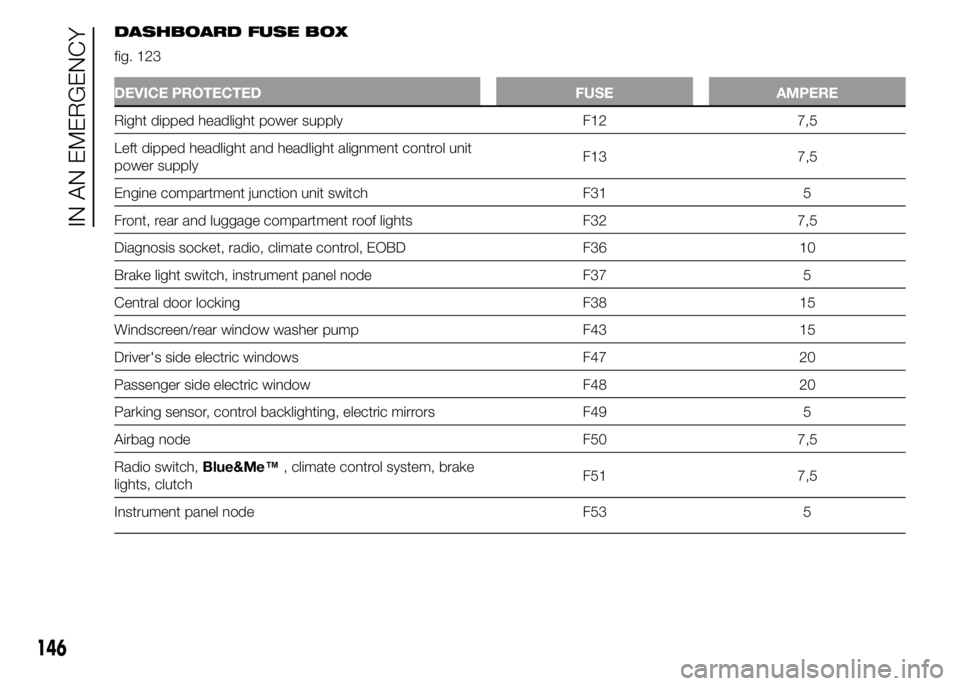
DASHBOARD FUSE BOX
fig. 123
DEVICE PROTECTED FUSE AMPERE
Right dipped headlight power supply F12 7,5
Left dipped headlight and headlight alignment control unit
power supplyF13 7,5
Engine compartment junction unit switch F31 5
Front, rear and luggage compartment roof lights F32 7,5
Diagnosis socket, radio, climate control, EOBD F36 10
Brake light switch, instrument panel node F37 5
Central door locking F38 15
Windscreen/rear window washer pump F43 15
Driver's side electric windows F47 20
Passenger side electric window F48 20
Parking sensor, control backlighting, electric mirrors F49 5
Airbag node F50 7,5
Radio switch,Blue&Me™, climate control system, brake
lights, clutchF51 7,5
Instrument panel node F53 5
146
IN AN EMERGENCY
Page 151 of 215
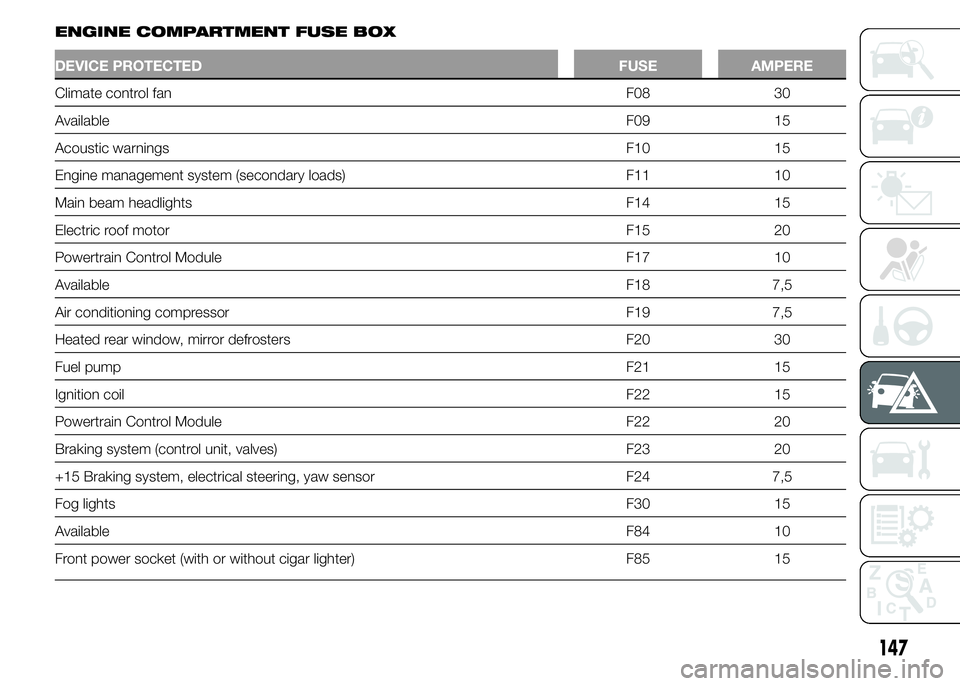
ENGINE COMPARTMENT FUSE BOX
DEVICE PROTECTED FUSE AMPERE
Climate control fan F08 30
AvailableF09 15
Acoustic warnings F10 15
Engine management system (secondary loads) F11 10
Main beam headlights F14 15
Electric roof motor F15 20
Powertrain Control Module F17 10
AvailableF18 7,5
Air conditioning compressor F19 7,5
Heated rear window, mirror defrosters F20 30
Fuel pumpF21 15
Ignition coilF22 15
Powertrain Control Module F22 20
Braking system (control unit, valves) F23 20
+15 Braking system, electrical steering, yaw sensor F24 7,5
Fog lightsF30 15
AvailableF84 10
Front power socket (with or without cigar lighter) F85 15
147
Page 157 of 215

SERVICING AND MAINTENANCE
Correct maintenance permits the
performance of the car to be
maintained over time, as well as limited
running costs and safeguarding the
efficiency of the safety systems.
This chapter explains how.SCHEDULED SERVICING ...............154
SCHEDULED SERVICING PLAN .....155
PERIODIC CHECKS ........................158
HEAVY-DUTY USE OF THE CAR .....158
CHECKING LEVELS........................159
AIR CLEANER/POLLEN FILTER ......162
BATTERY ........................................162
WHEELS AND TYRES.....................164
RUBBER HOSES ............................165
WINDSCREEN/REAR WINDOW
WIPER ............................................165
BODYWORK ...................................167
INTERIORS .....................................169
153